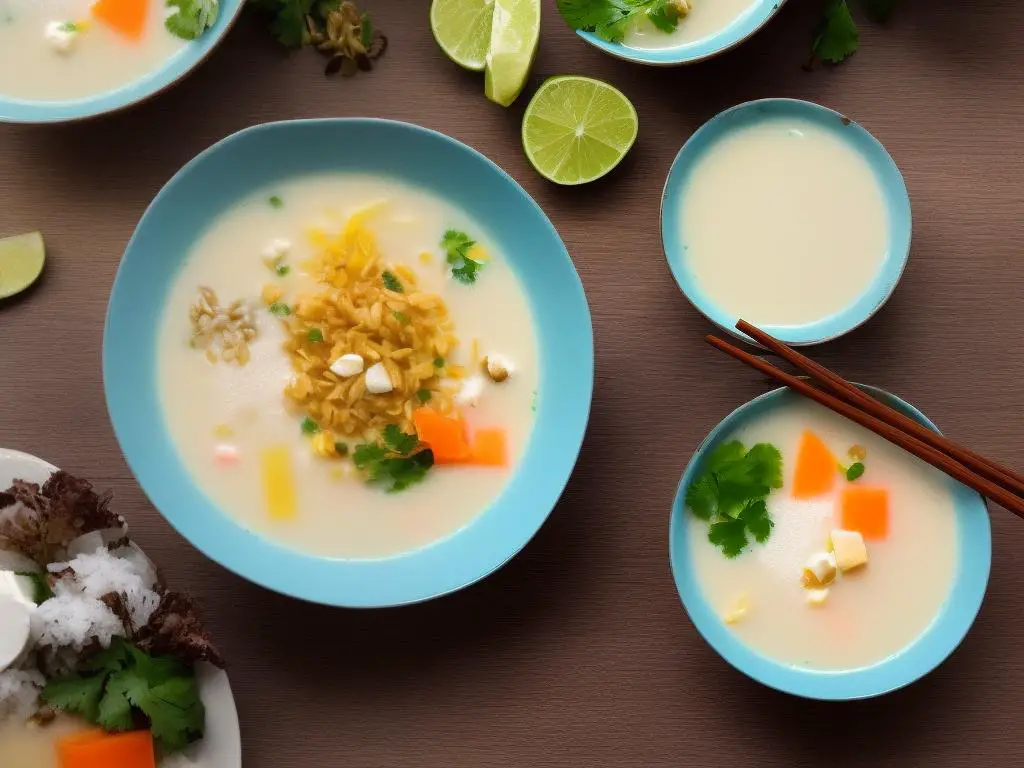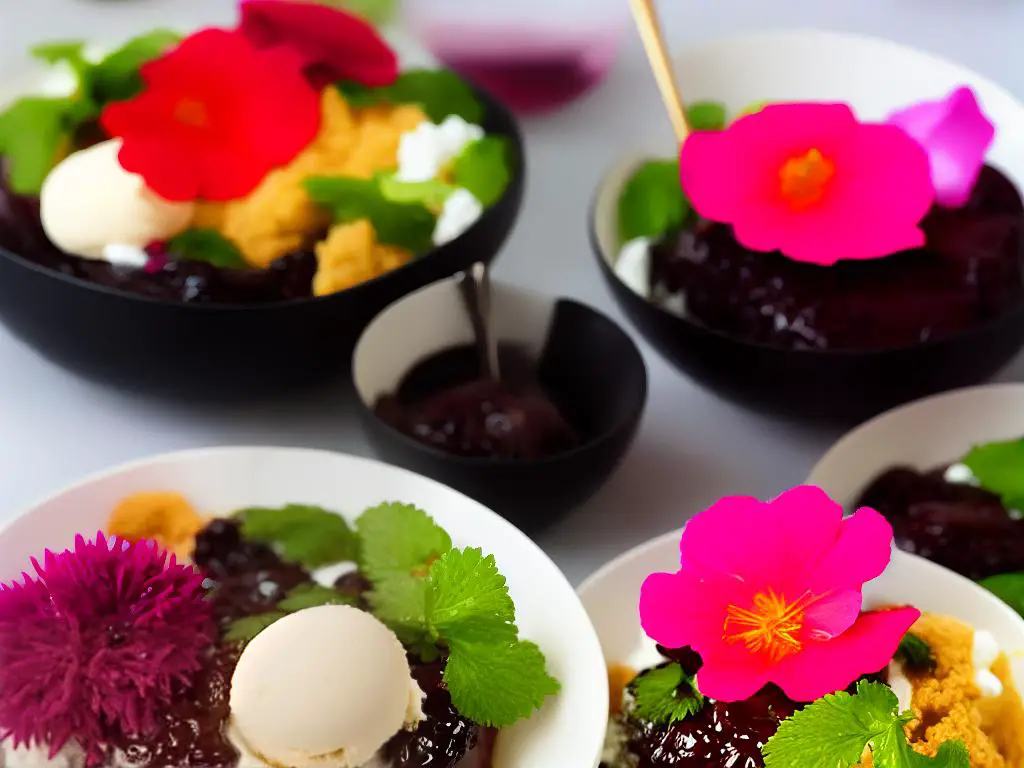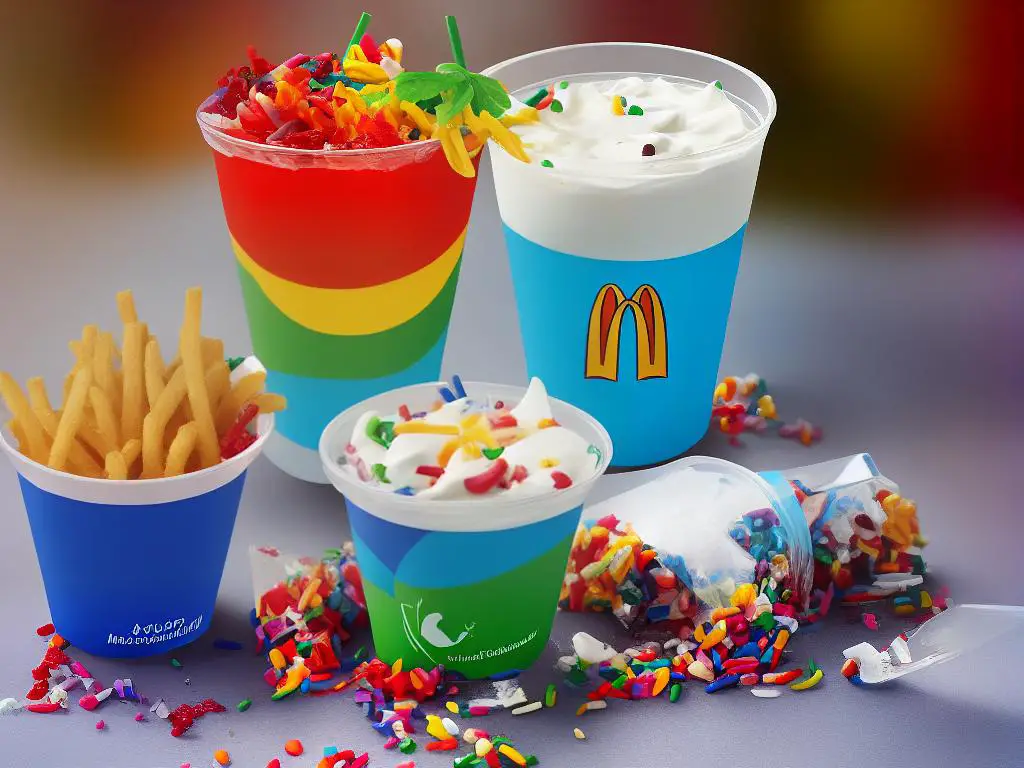Thai cuisine, which is renowned for its delectable dishes and vibrant flavours, often incorporates a range of diverse ingredients that tantalise the taste buds. One such traditional dessert that has captured the hearts of both locals and tourists alike is Bualoy. This essay delves into the origins and key ingredients of Bualoy, highlighting its significance in Thai culture. Furthermore, the discussion focuses on an intriguing adaptation by McDonald’s Thailand, as they offer a unique take on the classic dessert through their 3-Color Bualoy Sundae. The analysis also uncovers the public’s reaction to this innovative dessert and its impact on McDonald’s Thailand’s market share and overall performance.
Origins and Ingredients of Bualoy
Bualoy – A Beloved Thai Dessert
Bualoy, a cherished Thai dessert, has been delighting the taste buds of locals and tourists alike for generations. The traditional dessert is usually served as a warm, comforting bowl of colourful rice flour balls swimming in a sweet coconut milk soup, with various fillings and toppings. Its popularity has led to numerous modern adaptations, including the introduction of the McDonald’s Thailand 3-Color Bualoy Sundae in 2020, which takes this beloved treat and transforms it into a tasty and refreshing ice cream dessert.
Origins of Bualoy
The history of Bualoy can be traced back to the Ayutthaya period in Thailand, dating back several centuries. There are various theories surrounding its origins, including the idea that it was introduced by Portuguese traders and missionaries in the 16th century. Over time, the dessert became ingrained into the culinary culture of Thailand, with each province adding its unique touch and flair to the dish.
Bualoy was initially considered a festive dessert and was served during celebrations and ceremonies such as Thai New Year or the Loi Krathong Festival. However, today, Bualoy is widely enjoyed throughout the year, in both its traditional form and innovative variations, including the McDonald’s Thailand 3-Color Bualoy Sundae.
Key Ingredients in Bualoy
The essential components of Bualoy include rice flour and coconut milk. To create the vibrant and chewy rice flour balls, a mixture of glutinous rice flour and water is combined to form a smooth dough, which is then divided and coloured with natural food colouring, such as pandan leaves for green and butterfly pea flowers for blue. The dough is rolled into small balls and placed in boiling water to cook until tender and float to the surface.
The rice balls are then combined with a sweet and slightly salty coconut milk soup, which is made by simmering coconut milk, sugar, and a pinch of salt. The overall taste is characterised by its delicate balance of sweet and savoury flavours. Some recipes add fillings to the rice balls, such as crushed peanuts or black sesame paste, and toppings like jackfruit or taro can also be incorporated into the dish.
McDonald’s Thailand 3-Colour Bualoy Sundae
The McDonald’s Thailand 3-Colour Bualoy Sundae offers a modern twist on the classic Bualoy dessert, highlighting the company’s commitment to celebrating Thai culture through fast-food innovation. This limited-edition sundae features McDonald’s soft-serve vanilla ice cream, complemented with colourful Bualoy rice balls, and drizzled with a delightful coconut milk sauce. The combination of cold ice cream and warm Bualoy creates a contrasting sensory experience while preserving the distinctive flavours and textures of the traditional dessert.

McDonalds’ Unique Take on Bualoy Sundae
Embracing Tradition: The Introduction of Bualoy Sundae
Bualoy, a popular Thai dessert, consists of small, colourful glutinous rice flour balls served in a sweet and fragrant coconut milk base. Though it is commonly found as street food throughout Thailand, its pairing with a sundae is an innovative addition courtesy of McDonald’s Thailand. The introduction of the 3-Colour Bualoy Sundae enables McDonald’s to successfully integrate elements of traditional Thai cuisine into their menu, catering to local tastes while maintaining the recognisable fast-food format that has global appeal.
Adaptation of Traditional Bualoy for McDonalds Thailand
Traditional Bualoy cooks rice flour balls in syrup made from coconut milk, sugar, and pandan leaves. The balls are often brightly coloured to entice and entertain the customer. One of the primary elements of difference between traditional Bualoy and McDonald’s Thailand’s 3-Color Bualoy Sundae lies in the method of adaptation for the fast-food market.
To achieve the desired balance, McDonald’s maintains the core of Bualoy with the three coloured rice flour balls: purple, pink, and green. They’ve replaced the broth of sweet coconut milk found in the original recipe with a soft serve vanilla ice cream to create the sundae. This adaptation allows the product to remain appealing to local Thai customers by retaining the core elements of the traditional dessert while adding the fast-food appeal of McDonald’s ice cream.
Distinctive Flavours and Presentation
McDonald’s Thailand’s 3-Color Bualoy Sundae showcases the rice flour balls as a topping on their soft serve vanilla ice cream. This creation offers a visually striking contrast between the brightly-coloured Bualoy balls and the classic McDonald’s sundae, drawing in customers who are eager to experience an innovative and unique Thai dessert.
The three colours of the Bualoy balls, pink, green, and purple, signify different natural flavourings. Natural ingredients, such as butterfly pea flower for the purple balls, pandan leaves for the green balls, and red lime paste for the pink balls add taste and visual appeal. These flavours, coupled with the creamy, cooling sensation of the ice cream, create a unique and delightful culinary experience for both locals and tourists alike.
McDonald’s Emphasis on Localisation
The creation of the 3-Color Bualoy Sundae showcases McDonald’s emphasis on adapting its menu to a specific country’s cuisine and preferences. The company’s focus on localisation is evident in various markets worldwide, where they often introduce exclusive menu items that cater to the tastes of that region.
In Thailand, the incorporation of traditional Bualoy into a McDonald’s product signifies the company’s continuous effort to cater to the demand for local food options in its markets. Offering such unique dessert options in addition to the standard McDonald’s fare appeals to a wider customer base and bolsters the brand’s presence in the rapidly growing Thai fast-food market.
Introduction
McDonald’s Thailand has introduced the 3-Colour Bualoy Sundae, a distinctive innovation that showcases a successful combination of local flavours and global fast food offerings. A delectable dessert incorporating elements of the traditional Thai Bualoy, the fast food variant appeals to Thai customers while also highlighting McDonald’s dedication to merging local culinary traditions with worldwide food trends. To appreciate this captivating creation, let us delve into the details of the 3-Colour Bualoy Sundae and examine its impact on McDonald’s Thailand and its customers.

Customer Reactions and Market Impact
The 3-Colour Bualoy Sundae
A vibrant addition to McDonald’s Thailand dessert offerings, the 3-Colour Bualoy Sundae presents a delightful fusion of taste and texture. Drawing on the traditional Thai dessert Bualoy, this sundae features three distinctively flavoured colourful Bualoy balls – pandan, butterfly pea, and roselle – all resting atop a bed of creamy vanilla soft serve. Given the attention this dessert has garnered among customers in Thailand, it is essential to examine the responses to this captivating creation, as well as its overall influence on McDonald’s Thailand’s market share and performance.
Social Media Buzz
As with many new products, social media plays a significant role in spreading the word about the 3-Color Bualoy Sundae. Users of platforms such as Instagram, Facebook and Twitter have been sharing their experiences with the dessert, with many posting pictures showcasing the colourful concoction. The hashtag #3colorbualoysundae has gained traction, with foodies and influencers alike showcasing the dessert and reviewing their experience. Overall, the reaction on social media has been predominantly positive, with users commending McDonald’s Thailand for incorporating traditional Thai dessert elements into the sundae.
Customer Reviews
Customer reviews of the 3-Color Bualoy Sundae are generally positive. Many people appreciate the unique combination of flavours and the incorporation of traditional Thai dessert elements into a modern, fast-food setting. Customers have also praised the dessert for its aesthetically pleasing presentation. However, a few customers have noted that while the dessert is indeed delicious, it may not be as remarkable or unique as they had initially expected. On various rating platforms, the 3-Color Bualoy Sundae has garnered a noticeable amount of ratings, with most being positive and demonstrating overall satisfaction with the dessert.
Market Impact
Although it is challenging to attribute McDonald’s Thailand’s market share and overall performance directly to one dessert, there are signs that the introduction of the 3-Color Bualoy Sundae has had a positive impact on the brand. Customers’ willingness to share their experiences on social media has led to increased exposure for McDonald’s Thailand, potentially driving more people to the restaurants to try the dessert for themselves.
The incorporation of local flavours and respect for Thai culture may have also had a positive effect on McDonald’s Thailand’s reputation. By showcasing traditional elements, McDonald’s demonstrates a commitment to understanding and meeting local tastes and preferences. As a result, the chain’s market share may stand to gain as Thai consumers continue to perceive McDonald’s as a company that knows and caters to their preferences.
In conclusion
Although it is impossible to directly attribute the public’s reaction to the 3-Color Bualoy Sundae to McDonald’s Thailand’s overall success, it is evident that the dessert has generated interest and approval among customers. Through social media buzz, positive customer reviews, and increased engagement with local culture and preferences, McDonald’s Thailand has potentially enhanced its relationship with its target audience and solidified its place in the Thai market. The 3-Color Bualoy Sundae can be seen as a testament to the brand’s ability to captivate and cater to its consumers’ tastes and expectations.

It is evident that McDonald’s Thailand’s 3-Color Bualoy Sundae demonstrates the power of combining cultural tradition with modern adaptations, as this unique dessert has garnered significant attention and piqued the interest of customers. Such innovations within the fast-food industry can have a profound impact on a company’s market share and overall performance, while simultaneously preserving and promoting traditional culinary delights. Ultimately, the story of the 3-Color Bualoy Sundae exemplifies how respecting the rich cultural history of a region and catering to contemporary consumer demands can result in a harmonious and successful fusion that benefits both the business and its patrons.
